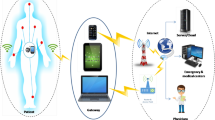Abstract
The cost efficiency of wireless platforms and their easy deployment enable the applicability of it in widespread application domains. Wireless sensor networks (WSNs) are not excluded from it. Their application domains vary from industrial monitoring to military applications. A WSN is a resource-constrained network and energy of the WSN node is a valuable resource. Like every other network, WSNs are also vulnerable to security attacks. A security attack can results in networks consuming more resources, leading to earlier depletion of node energy. A significant part of the resource consumption in a WSN is controlled by the medium access control (MAC) mechanism. This paper focuses on WSN MAC mechanisms and countermeasures for attacks targeting the MAC layer in a WSN. Denial of sleep attacks are the most relevant for WSN MAC as these types of attacks have shattered effects, which bring down the sensor lifetime from years to days. This paper proposes a secure hybrid MAC mechanism, Green and Secure Hybrid Medium Access Control (GSHMAC) to overcome the devastating effect of WSN MAC attacks. The proposed mechanism provides features such as collision threshold-based MAC mode control and countermeasures on WSN MAC using internal MAC mechanisms. GSHMAC shows improved energy-efficiency, delay, and throughput in the presence of attacks, as compared with state-of-art secure MAC mechanisms.






Similar content being viewed by others
References
Anastasi, G., Conti, M., Di Francesco, M., & Passarella, A. (2009). Energy conservation in wireless sensor networks: A survey. Ad hoc Networks, 7(3), 537–568.
Chen, X., Makki, K., Yen, K., & Pissinou, N. (2009). Sensor network security: A survey. IEEE Communications Surveys & Tutorials, 11(2), 52–73.
Pawar, P. M., Nielsen, R. H., Prasad, N. R., Ohmori, S., & Prasad, R. (2012). Activity modelling and comparative evaluation of WSN-MAC security attacks. Journal of Cyber Security and Mobility, 1(3), 205–225.
Abbasi, A. A., & Younis, M. (2007). A survey on clustering algorithms for wireless sensor network. Elsevier Computer Communication, 30(14–15), 2826–2841.
Pawar, P.M., Nielsen, R.H., Prasad, N.R., Ohmori, S., Prasad, R. (2011). Hybrid mechanisms: Towards an efficient wireless sensor network medium access control. In WPMC, Brest, France (pp. 1–5).
Eisler, M., Labiaga, R., Stern, H. (2001). Chapter 17: Network performance analysis. In M. Loukides (Ed.), Managing NFS and NIS (pp. 168–216). Sebastopol: O’Reilly.
Ren, Q., Liang, Q. (2004). Secure media access control (MAC) in wireless sensor networks: intrusion detections and countermeasures. In PIMRC, Barcelona, Spain (pp. 3025–3029).
Brownfield M., Gupta, Y., Davis N. (2005). Wireless sensor network denial of sleep attack. In IEEE IAS, West Point, NY, USA (pp. 356–364).
Raymond D.R., Midkiff S.F. (2007). Clustered adaptive rate limiting: defeating denial-of-sleep attacks in wireless sensor networks. In MILCOM, Orlando, FL, USA (pp. 1–7).
Raymond, D. R., Marchany, R. C., Brownfield, M. I., & Midkiff, S. F. (2009). Effects of denial-of-sleep attacks on wireless sensor network MAC protocols. IEEE Transactions on Vehicular Technology, 58(1), 367–380.
Kulkarni, R.V., Venayagamoorthy, G.K., Thakur, A.V., Madria, S.K. (2009). Generalized neuron based secure media access control protocol for wireless sensor networks. In MCDM, Nashville, TN, USA (pp. 16–22).
Chen C., Hui, L., Pei, Q., Ning, L., Qingquan, P. (2009). An effective scheme for defending denial-of-sleep attack in wireless sensor networks. In Proceedings of IEEE 5th International Conference on Information Assurance and Security, Xi’an, China (pp. 446–449).
Rao, P.S., Varma, K.V.S.R.P., Satapati, R., Vamsidhar, E. (2010). Multilayer perceptron based secure media access control protocol for wireless sensor networks. In ICCIC, Coimbatore, India (pp. 1–5).
Hsueh, C.-T., Wen, C.-Y., Ouyang,Y.-C. (2012). Two-tier receiver-initiated secure scheme for hierarchical wireless sensor networks. In ITST’ 12, Taipei, Taiwan (pp. 254–258).
Bhattasali, T., Chaki, R., & Sanyal, S. (2012). Sleep deprivation attack detection in wireless sensor network. International Journal of Computer Applications, 40(15), 19–25.
Qian, Y., Zhou, J., Qian, L., Chen, K. (2006). Highly scalable multihop clustering algorithm for wireless sensor networks. In ICCCAS’ 06, Guilin, Guangzi, China (pp. 1527–1531).
Pawar, P.M., Nielsen, R.H., Prasad, N.R., Ohmori, S., Prasad, R. (2012) GCF: Green conflict free scheduling algorithm for WSN. In ICC-E2Nets’ 12, Ottawa, Canada (pp. 5795–5799).
Pawar, P.M., Nielsen, R.H., Prasad, N.R., Prasad, R. (2014). A hybrid algorithm for efficient wireless sensor network time synchronization. In Wireless VITAE’ 14, Aalborg, Denmark (pp. 1–5).
Author information
Authors and Affiliations
Corresponding author
Rights and permissions
About this article
Cite this article
Pawar, P.M., Nielsen, R.H., Prasad, N.R. et al. GSHMAC: Green and Secure Hybrid Medium Access Control for Wireless Sensor Network. Wireless Pers Commun 100, 267–281 (2018). https://doi.org/10.1007/s11277-017-5065-7
Published:
Issue Date:
DOI: https://doi.org/10.1007/s11277-017-5065-7




